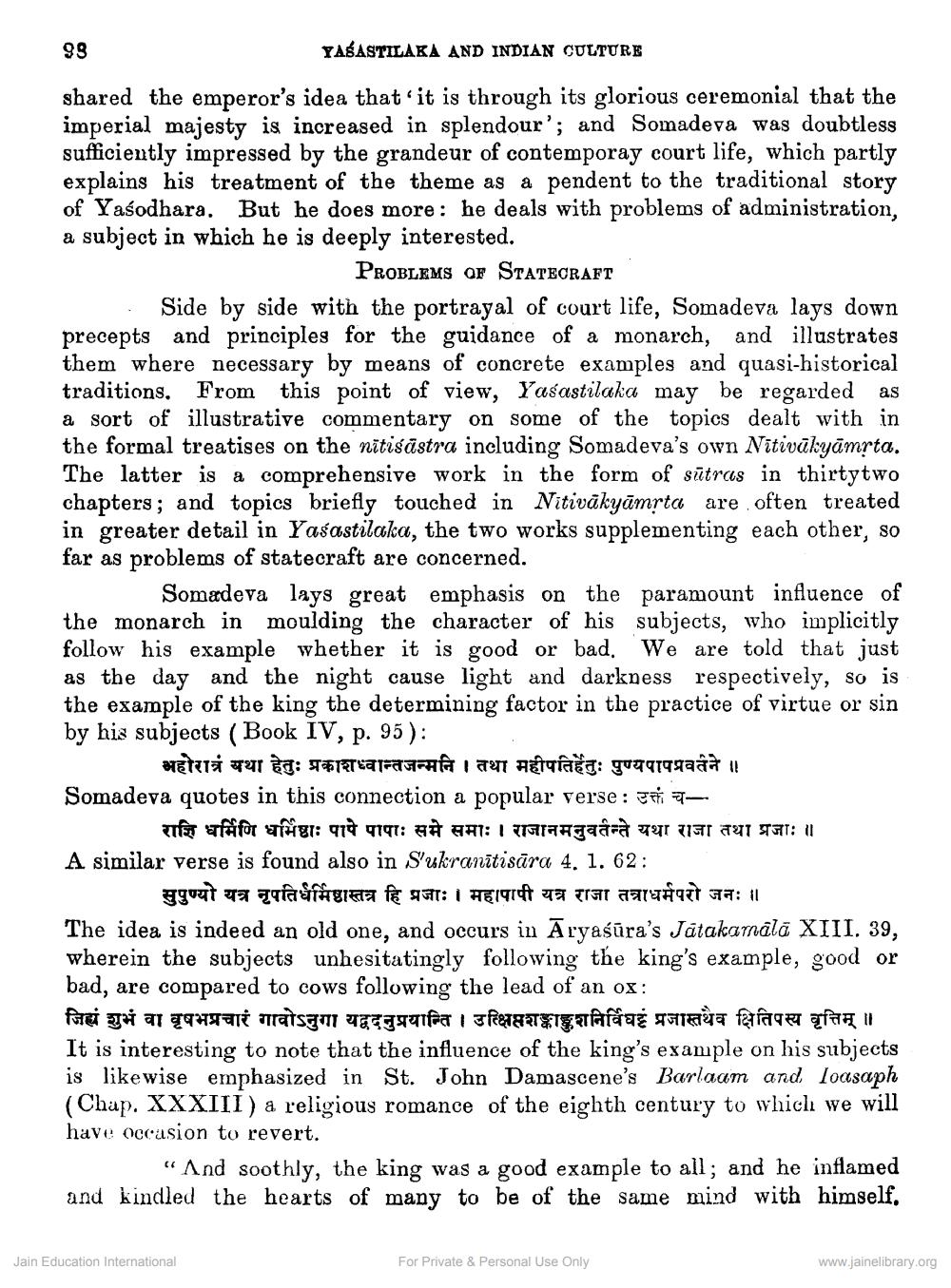________________
YASASTILAKA AND INDIAN CULTURE
shared the emperor's idea that 'it is through its glorious ceremonial that the imperial majesty is increased in splendour'; and Somadeva was doubtless sufficiently impressed by the grandeur of contemporay court life, which partly explains his treatment of the theme as a pendent to the traditional story of Yasodhara. But he does more: he deals with problems of administration, a subject in which he is deeply interested.
PROBLEMS OF STATECRAFT
as
Side by side with the portrayal of court life, Somadeva lays down precepts and principles for the guidance of a monarch, and illustrates them where necessary by means of concrete examples and quasi-historical traditions. From this point of view, Yasastilaka may be regarded a sort of illustrative commentary on some of the topics dealt with in the formal treatises on the nitisāästra including Somadeva's own Nītivākyāmṛta. The latter is a comprehensive work in the form of sutras in thirtytwo chapters; and topics briefly touched in Nitivākyāmṛta are often treated in greater detail in Yasastilaka, the two works supplementing each other, so far as problems of statecraft are concerned.
99
Somadeva lays great emphasis on the paramount influence of the monarch in moulding the character of his subjects, who implicitly follow his example whether it is good or bad. We are told that just as the day and the night cause light and darkness respectively, so is the example of the king the determining factor in the practice of virtue or sin by his subjects (Book IV, p. 95):
अहोरात्रं यथा हेतुः प्रकाशध्वान्तजन्मनि । तथा महीपतिर्हेतुः पुण्यपापप्रवर्तने ॥ Somadeva quotes in this connection a popular verse:
राशि धर्मिणि धर्मिष्ठाः पापे पापाः समे समाः । राजानमनुवर्तन्ते यथा राजा तथा प्रजाः ॥
A similar verse is found also in S'ukranitisāra 4. 1. 62:
सुपुण्यो यत्र नृपतिर्धर्मिष्ठास्तत्र हि प्रजाः । महापापी यत्र राजा तत्राधर्मपरो जनः ॥
The idea is indeed an old one, and occurs in Aryaśūra's Jātakamālā XIII. 39, wherein the subjects unhesitatingly following the king's example, good or bad, are compared to cows following the lead of an ox:
जिह्यं शुभं वा वृषभप्रचारं गावोऽनुगा यद्वदनुप्रयान्ति । उत्क्षिप्तशङ्काङ्कुशनिर्विघट्ट प्रजास्तथैव क्षितिपस्य वृत्तिम् ॥ It is interesting to note that the influence of the king's example on his subjects is likewise emphasized in St. John Damascene's Barlaam and loasaph (Chap. XXXIII) a religious romance of the eighth century to which we will
have occasion to revert.
"And soothly, the king was a good example to all; and he inflamed and kindled the hearts of many to be of the same mind with himself,
Jain Education International
For Private & Personal Use Only
www.jainelibrary.org




